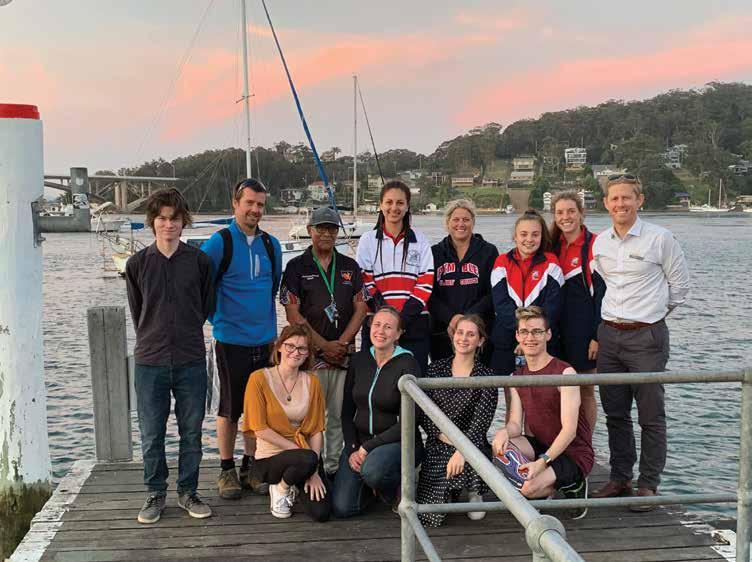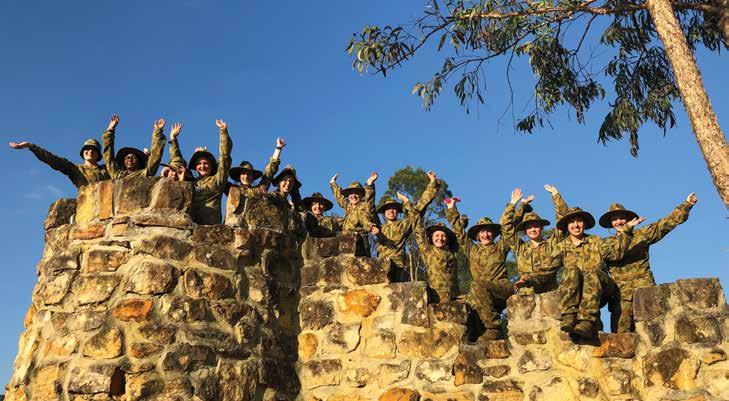
4 minute read
A personal experience combining academic research with secondary teaching
Learning about our Indigenous culture, Kariong, NSW Central Coast. Left to right. Back row: Sarah Boyd, Libby Woodhill, Layla Hickson, Charlotte Lowe, Freida Kerr, Rhonda Kerr, Alexandra Egan, Miss Kate Howie, Kyana Cvetkovic. Front Row: Summer Humes, Lili Wymond, Shakira Tyson, Isabelle Docker, Olivia Anderson
By Ryan Stewart, History Teacher
My PhD thesis is titled Remembering Contact History on the Central Coast of New South Wales. Why this topic and why now? In this article, I explore the questions of why this topcs and why now?’ My supervisors are Associate Professor Nancy Cushing and Professor Lyndall Ryan from the University of Newcastle. My supervisors and I bemoan the lack of academic research on frontier contact where I live, on the Central Coast, and my thesis aims to hopefully fill aspects of this void. Why me? I’ve lived in Bateau Bay most of my life (except for four years in the eastern suburbs of Sydney). I’m nonIndigenous, a complete ‘white fulla’, however, I was lucky enough to have a grandfather in Keith Whitfield, former deputy mayor of Gosford Council. My grandfather showed me Indigenous sites on the Coast in the late 1980s and early 1990s – this sparked my interest. I then undertook Aboriginal Studies for my HSC, became a History teacher and here I am today teaching History at Pymble. Even as a ‘white fulla’, when I move around this country, I feel the presence of the First Nations peoples and their story and experiences of contact need to be told. The impact of disease, violence and dispossession on the First Nations peoples of the region we now call the Central Coast was nothing short of horrendous.
POSTGRADUATE STUDIES
Unfortunately, most residents don’t know anything about the experiences of the First Nations peoples in this region during the frontier period. The first British person to inquire about the experiences of the people in this area was none other than the poet Henry Kendall who, after living in West Gosford for two years and talking to settler-colonists of the region, reported in the Town and Country Journal in 1875 that “in the middle of the night, camp after camp was surprised, and the occupants, men, women and children, shot down like native dogs”. In 1879 he further stated that the ears of Indigenous men were taken by settlers in order to be paid bounties and that “40 or 50 years ago soldiers had shot everything before them – that is to say every ‘blackskin’ – men, women and children.”
After disease, the abduction of women and land dispossession, the apex of frontier contact on the Central Coast was characterised by violence and the near destruction of the peoples here. Kendall’s references to massacres on the Central Coast do not appear on Professor Lyndall Ryan’s digital frontier massacre map as, at this point, we do not have other sources to corroborate his account. One burning question that drives my thesis is: why haven’t these violent contact experiences been explored and communicated?

Tiarna Williams with Uncle Gavi Duncan, a First Nations Elder, at the site of first contact in 1788 between Governor Philip’s men and the First Nations peoples of the Central Coast at Pearl Beach.
With the death of the man whom settler-colonists designated as the “last of the Brisbane Water blackfellows”, Billy Fawkner, in 1874 in Tuggerah Lake, settler-colonists saw no reason to tell the First Nations story as they believed they were extinct. When settlercolonists started to write the history of the Central Coast from the 1950s onwards, they made statements like “these friendly and worthy people” are “no longer with us” and that “there is little to remind us of those vanished tribes who inhabited these forested lands for countless generations.”
This notion of Indigenous disappearance on the Central Coast was further added to by archaeologist Patricia Vinnicombe who was employed by National Parks to catalogue First Nations sites on the Central Coast – who claimed, in 1980, that she could not find anyone in the region who claimed ‘Aboriginality.’ Such was the devastating impact of contact and dispossession. Yet the First Nations community was still there waiting for acknowledgement and here we are today at Pymble with the next generation of Indigenous students who now have the opportunity to gain a more complex understanding of the people, the sites and the culture that has enriched this region between the North Shore and the Central Coast for thousands of years. In order to assist with this, I collaborated with our Indigenous Students’ Co-ordinator Kate Howie to take some of our Indigenous students to sacred First Nations sites on the Central Coast. We embarked on our first expedition in 2017 to rock engraving sites at Kariong, where the students gazed upon beautiful petroglyphs of the First Nations creator spirit Biami and magnificent carvings of giant whales. In 2019, in collaboration with the University of Newcastle, we took some Year 11 Indigenous students to significant contact sites on the Central Coast and our students were lucky enough to hear stories about the First Nations perspective of contact from Darkinjung Land Council elder Uncle Gavi Duncan. It was extremely fulfilling to be able to assist with providing these opportunities for our Indigenous girls and such experiences provide real-world linkages between academic research, high school education and cultural enrichment.
My PhD thesis is due for submission in 2024 (eight years part-time) and I look forward to continuing to share my research with Pymble’s learning community.
Uncle Gavi Duncan with Pymble staff and students, and other students, at Booker Bay, Central Coast. This is the site of the first land grant to settler-colonist, James Webb, in 1823.











